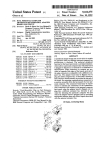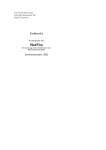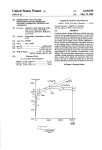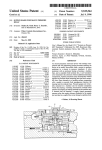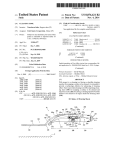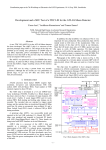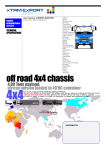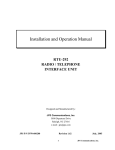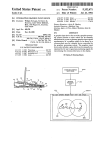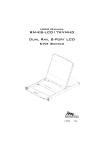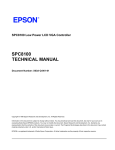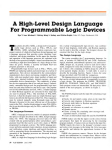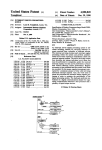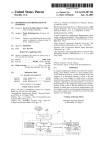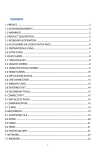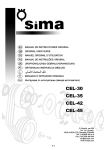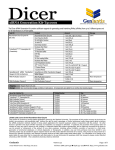Download llllllllllllllIllIlllllllllllllllllllllllllllllllllIllllllllllllllllllllll
Transcript
llllllllllllllIllIlllllllllllllllllllllllllllllllllIllllllllllllllllllllll USO05163833A United States Patent [191 [11] [45] Olsen et al. [54] DUAL PERSONAL COMPUTER ARCHITECTURE PERIPHERAL ADAPTER BOARD [751 Inventors: Derek S. Olsen, San Jose; Richard D. Cavaness, Fremont; Gail R. Snyder, San Jose, all of Calif. [73] Assignee: Digital Communications Associates, Inc., Alpharetta, Ga. Int. Cl.5 ............................................. .. HOSK 7/10 Field of Search ........... .. 439/59, 61, 62, 170-173, 439/65, 79, 80; 361/399, 413, 415, 427; 364/708 Meade et al. . Huston, Jr. ....................... .. 364/200 4,291.370 Charles . . . .. 4,309,754 l/1982 Dinwiddie, Jr. Adcock 4,447,878 5/1984 Kinnie et a1. 4,473,755 4,575,793 9/1984 3/1986 364/200 364/200 ... .. .. .... . . . .. 364/200 364/200 Imani et a1. .............. .. 307/101 Morel et a1. ................... .. 364/200 4,901,205 4,936,785 4,885,482 12/1989 2/1990 6/1990 Krug Sharp Landiseteteta1. a1. a1.. ......................... .. 439/75 FOREIGN PATENT DOCUMENTS 08801008 9/1988 function for the board and circuit is a terminal emulator, which allows a personal computer into which the board is plugged to function as a terminal for a mainframe or minicomputer. Edge connectors or contacts are pro the edge connectors is compatible with a different com puter bus, The adapter board may be ?ipped over to 3,993,936 11/1976 4,287,563 9/1981 . . . . . r . . . .. ABSTRACT A peripheral adapter board and circuit which is capable for operation with two different personal computer bus architectures is disclosed. The preferred peripheral vided on opposite side edges of the board; each one of References Cited U.S. PATENT DOCUMENTS 4/1984 nection”; Computer Design, vol. 23, No. 2, Feb. 1984, pp. 231-236. [57] US. Cl. .................................... .. 439/61; 361/413; 4,443,846 1988, pp. 131-132, Armonk, NY, entitled “Adapter Card for Personal Computer”. D. Erlin, “Establishing the Micro-to-Mainframe Con Primary Examiner—Neil Abrams Division of Ser. No. 339,186, Apr. 14, 1989. 9/1981 OTHER PUBLICATIONS IBM_ Bulletin, Bardo, vol. 20, No. 1, p. 89, Jun. 1977. IBM Technical Disclosure Bulletin, vol. 31, No. 5, Oct. Attorney, Agent, or Firm—Jones, Askew & Lunsford 439/79; 439/170 [56] Nov. 17, 1992 user manual; 1988. Related US. Application Data [58] 5,163,833 Excerpt from Devlonics Terminals N.V. modem card [21] Appl. No.: 781,510 Oct. 22, 1991 [22] Filed: [62] [511 [52] Patent Number: Date of Patent: plug into either computer bus. A removable, reposition able connector board assembly is provided at one end of the board, for mounting communications connectors in a position accessible from the back panel of a host per sonal computer. The connector board may be reposi tioned to maintain the orientation of the communica tions connectors with respect to the personal computer back panel when the adapter board is flipped over to plug into a different computer bus. Circuitry is pro vided for detecting the particular computer bus into which the adapter board is plugged, and for providing appropriate address, data, and control signals associated with the selected computer bus. Belgium . 0350573 l/1990 European Pat. Off, . 3808364 9/1989 Fed. Rep. of Germany . CONVERTIBLE DUAL BUS ADAPTER 29 Claims, 12 Drawing Sheets US. Patent Nov. 17, 1992 Sheet 1 of 12 5,163,833 US. Patent Nov. 17, 1992 Sheet 2 of 12 5,163,833 US. Patent Nov. 17, 1992 Sheet 3 of 12 5,163,833 US. Patent Nov. 17, 1992 Sheet 5 of 12 5,163,833 US. Patent Nov. 17, 1992 Sheet 6 0f 12 5,163,833 J2 m D. T m B m29E anr wEmv8 w o. M w m“566.0 I“II].|lIIl 1|; I1|lI|1lr _ _ _ _ _ _ _ _ an a a 1., 4s W 5 _ _ 1.2.1 A. 4 ‘We 4A 3L a an w . m.8i\|“5.60 US. Patent Nov. 17, 1992 _ 13A - INTERRUPTS ENABLE SYSCLK /186|NT|N SYSCLK l186lNTIN ICDSETUP (AEN) lCDSETUP (AEN) IMEMCS16 /MEMCS16 I /coos1s ‘ 5,163,833 INTERRUPT VECTOR SELECT TYPE 12° N 4 Sheet 8 0f 12 /CDDS16 lCDSFDBK -/CDSFDBK GLOBALREAHMBASESELECT STROBESFORREGISTERBAWGO coMIeIIIIAIIoIIPEsIsIEIIMM 160 PC N M‘ I I ' ' emmmwm BUS M00 1 'G A REG KIACAIUENABE ' IIUJIMSESLCT 5; PARENT m E; LATCH MCAJR- INT TYPE m; ATOR snIIIMsa:. 159 IIIuIsmIIIIIE “o SE56; '55153 L551 ' PJ ENABLE - IRMA ENABLE L PCASEGMENT “WWW — 'BM “AMEN-v ENABLE sIIIIAMsEsLcT PJBASESLCT — I $3 LATCHUUSE Q mm ‘ IRMAENABLE Wm, IBNMSEH .m PCAJR mm“ PJ ENABLE REARM BASE i» WWW ‘A. H m LAs-LAo 152 BASE —T 3PORTPAMEN WWW IGLOBAL Mm -nw PCAIO u E BASESLCT \ NIvEcIsBEcI lRST _. LA2-LAO McAIo KAUCACUFE'B'EG INTENABLE __ > —+>IIcIIIoaIsEsIc1 ‘ _l MCA CARD ENABLE IBM ENABLEHI 1: 55 ‘5 PJBASEEL :: m1, I: :: 1mm comen'Per noIIaIIsssIcI M m RMBAESLCT M “WNW Iu'TIImI'nIoII' MATCH LINE T0 FIG Tao Km m 3 LATGIPJBASE é Immum < 2 LA3-LA° . .IaeAsEEE IAIcImaAss E: LAa-LAo 52 WWW :: :: LATGIPMNSE 35 55 ;: IIIIIIIIIEEE ;; 158 % ;; SHMBASESEECT SIRMAENABLE PJBASESFlFP-T LA3- LAO E IE E: ' US. Patent Nov. 17, 1992 VECTOR SELECT TNTEBBUPT TYPE INTERRUPTS ENABLE SYSCLK /186|NT1N Sheet 9 of 12 5,163,833 IGLOBAL REARM GLOBAL REARM ADDRESS STROBES FOR REGISTER BANK 160 EMULATW mm ‘ REGISTER BANK PC was ' 168 016g; ,1‘. Hmmsume MD a/WR necooe 5i _ WSUAUSOUNDREG E: _,cLPsonAmmEe _ grain; — PCA -: m I: W #1: . g» LATCH IBM BASE LATCH SIRMA BASE -: ‘m _$IERMINALIDREG LATCH PJ BASE Ii LATCH IRMA BASE H '| IRD &/WR PJ 1; DEOODE E: LATCH JR BASE LA3 - LAo JR -» CONTROL REG :1 m 050002 :5 ’ scm m _;PAEMDPEG — “mm - & ~ 900 ‘AM’ :3 H T ‘ 1 ' ' v 120 (/ , E V P-EB7ESTATUSHEG B. ‘ if 1 Mamas ‘ ;: _ ' PAEGMBEG ummessw? JR TIMING :: :2 * INTERRUPH86 (167 “SIRMAONLY mum necoos LATCH ALL BASE \ PJaMmBTAcEs COMPUTERTNTERFACE GATEARRAY 133 i MATCH LINE T0 FIG 13D DATA , BUS I: m. 5-‘ WCHMBASE ‘ 190 REG m0 8‘ IWR LATCHRMBASE mo &/WR cum ‘ IIRQA , JR ‘ _ ;: LA3 - LAO Ma — WWW :~ mm & NVR LA3 - LAO I mmmm LA2 _ LAO GLOBALREARMBASE T0FLM1AI3TNCGAEH 1Q ~ LATCH SETUP BAsE 1m $6? [186mm : 1 5,163,833 2 PC/AT adapter cards, as well as to provide an upgrade path to a 32-bit architecture which is compatible with at DUAL PERSONAL COMPUTER ARCHITECTURE PERIPHERAL ADAPTER BOARD least some existing interface adapters. Many computer installations will inevitably wind up with a mix of MCA 5 machines, PCA machines, EISA machines, and perhaps CROSS REFERENCE TO RELATED APPLICATION even other personal computer architectures such as the NuBus architecture. The proliferation of bus architec This is a division of application Ser. No. 07/339,186, tures has created a need for interface adapter boards for ?led Apr. 14, 1989, by Olsen et al., entitled “Dual Per sonal Computer Architecture Peripheral Adapter 10 personal computers which increases flexibility in mov ing the boards from computer to computer for up Board and Circuit”. grades, enhancements, replacement, and the like. TECHNICAL FIELD A related problem faced by owners is computer in ventory or asset maintenance and control. The need to The present invention relates to peripheral adapter provide a different peripheral adapter for each different boards of the type which fit into expansion slots associ ated with personal computers, and more particularly 5 type of personal computer utilized, even though the basic functions of the peripheral adapters may be the relates to a terminal emulator peripheral adapter board same, makes the tasks of selecting, acquiring, storing, capable of operation with two discrete computer bus maintaining, and repairing a large number of different architectures. BACKGROUND OF THE INVENTION peripheral adapters unnecessarily complicated. It 20 would be more efficient if a single function peripheral Owners and operators of personal computers regu larly must face the fact that changes in computer tech nology move beyond the technology embodied in a particular machine in which they have invested. As adapter were operative in more than one computer bus architecture. Accordingly, there is a need in the computer industry for an adapter board that is compatible with and can be computer manufacturers advance to new generations of 25 plugged into more than one type of computer bus archi equipment, they often change to a new bus architecture. tecture. An example is the adoption of Micro Channel Architec SUMMARY OF THE INVENTION ture (MCA) by International Business Machines Corpo ration (IBM) for use in IBM PS/Z personal computers, The present invention solves the aforementioned and to replace the widely popular Personal Computer Ar chitecture (PCA) previously used in IBM PC , PC XT, 30 other problems in the art discussed above by providing an adapter board capable of operation with either of two discrete computer bus architectures. The preferred and PC AT computers. Peripheral device interface circuits embodied in adapter cards provided with edge adapter board is operable in at least two different com contacts compatible with the PCA system cannot be puter bus architecture environments: the IBM PC/AT 35 used with the MCA system, and conversely. Thus, a user who is considering upgrading to a new generation of computer technology which employs a different bus architecture must replace not only the central processing unit, but all of the peripheral device interface adapters purchased for use in connection with the earlier machine. This may include terminal emula tors for communicating with mainframe computers, environment, now commonly referred to as the Per sonal Computer Architecture (PCA) environment, and the PS/2 environment, now commonly referred to as the Micro Channel Architecture (MCA). An adapter board embodying the present invention includes two different bus connector means, each asso ciated with one of the two architectures, PCA and MCA, and circuit means for interfacing between the two different bus architectures and a peripheral func printer interfaces, and the like. If, for example, a copo ration decides to provide terminal emulation capability 45 tion. The disclosed peripheral function is a terminal emulator function. The terminal emulator functions for a large group of personal computers to enable them which are accessible to personal computer applications to communicate with the corporation’s mainframe com or drivers (e.g., the known IRMA, P], IBM, and the puter, the purchase of an adapter board for each of the like emulator drivers) comprise both hardware re personal computers is usually required. However, if the corporation also is considering upgrading the personal 50 sources such as input/output ports and a display RAM, as well as microcoded services provided by a micro computers to machines with a different, perhaps more processor which is dedicated for 3270 protocol han advanced, bus architecture, it faces a dilemma. If the dling functions. needed capability is immediately purchased, it may Although in the preferred embodiment the adapter have to be purchased again in the form of new adapter boards compatible with the new bus architecture. If the 55 board comprises a terminal emulator, other types of peripheral functions may be implemented. Accordingly, corporation postpones upgrading to the new bus archi the present invention is not limited to a terminal emula tecture, it will be sacri?cing the needed terminal emula tor, and will also be useful for peripheral functions such tion capability during the interim period. modems, memory expansion cards, graphics adapters, Another aspect of the difficulties faced by personal computer users and owners is the current competition between the MCA personal computer bus and the Ex Itended Industry Standard Architecture (EISA) per sonal computer bus. Certain manufacturers of “clones” of the popular IBM PCA bus architecture have recently as memory expansion board, data acquisition circuits, graphics adapters, modems, etc. The preferred embodiment is a 3270-type emulation adapter which provides an IBM PC or compatible per sonal computer or an IBM PS/2 model personal com puter with an interface to IBM 3270 control units, embarked upon a course of action to promote the 32-bit 65 thereby allowing the personal computers to emulate IBM 3278 and 3279 display stations, or an IBM 3287 EISA bus as an alternative to the MCA bus. The EISA bus is being promoted at least partly to postpone the obsoletion of older 8-bit PC bus adapter cards and 16-bit printer. As will be understood by those skilled in the art, in the 3278/3279 emulation mode, the circuit appears to 3 5,163,833 a mainframe computer to be a 3278 or 3279 display station. In order to receive communications from a main frame control unit or cluster controller, the preferred embodiment includes external communication connec tors for electrical connection and communication with remote devices. The preferred external connector is provided on a removable, dual position connector board assembly which is movable between a ?rst posi tion with respect to the adapter board and a second position with respect to the board. Thus, the adapter board may be used with either of the bus architectures and the external connector board, and its associated communications connectors, may be positioned to be 4 of two discrete computer bus architectures while pres enting the same con?guration of external connectors associated with the board. It is a further object of the present invention to pro vide a terminal emulator board or card that can be used with a personal computer having a PCA bus architec ture or with a different personal computer having an MCA bus architecture. Other objects, features and advantages will become apparent upon review of the following detailed descrip tion of the preferred embodiment of the invention, when taken in conjunction with the drawing and the appended claims. the computer housing or cabinet. It will be appreciated that the preferred bus connec tor means comprise electrical edge contacts compatible with the expansion slots of the respective bus architec tures. In the preferred embodiment disclosed below, the BRIEF DESCRIPTION OF THE DRAWINGS FIG. 1 is a schematic perspective of an IBM PC/AT personal computer and an IBM PS/Z Model 50 personal computer, showing the removal of an adapter board constructed in accordance with the present invention from one of the computers and recon?guration for use in the other computer. FIG. 2 is a side plan view of the component side of an external communications connector may be a BNC type coaxial connector, an RJ-ll connector, or both. use with an MCA computer bus architecture, without compatible with the particular bus architecture to 15 which the board is connected while still maintaining physical alignment with openings in the back panel of adapter board embodying the invention, assembled for More particularly described, the invention provides a 25 card holder, retainer, and backplate. computer adapter board including a main circuit board, FIG. 3 is a detailed side plan view of a removable and and external communication connector means for en repositionable external communication connector abling the board to be connected to a device located off board which forms a part of the preferred embodiment the board, with the connector means being mounted on shown in FIG. 2. a removable section of the main circuit board. The 30 FIG. 4 is an exploded perspective view of the remov removable section is received in either of two orienta able connector board shown in FIG. 3. tions by the main board, so as to place the external ‘FIG. 5 is a vertical cross-sectional view taken along connector means in either of two orientations. In the line 5—5 of FIG. 2. preferred embodiments, the removable section is slid FIG. 6 is a side plan view of a holder which retains ably received within an area cut out of the main board. 35 the removable connector board of FIG. 3. The removable section preferably includes two connec FIG. 7 is an end plan view of the holder of FIG. 6. tors, one of which will be positioned to engage a mating FIG. 8 is an end plan view of the removable connec connector on the main board in either of the two orien tor board assembly. tations of the removable section. FIG. 9 is an exploded perspective view of the main It will thus be seen that a computer user considering 40 circuit board, the removable assembly and hardware a future upgrade to a new computer with a different bus used to interface the adapter board with an MCA bus architecture could purchase a needed adapter board architecture. embodying the present invention and have compatibil FIG. 10 is an exploded perspective view of the main ity with both the old and new bus architectures. The circuit board, removable connector board assembly, user thus will not have to replace several expensive 45 and hardware used to interface the adapter board with adapter boards when upgrading the underlying system, and can merely recon?gure the adapter board for the a PCA bus architecture. FIG. 11 is a schematic diagram of the circuitry of the new architecture when the new computer is acquired. removable connector board, connecting the external Thus, it is an object of the present invention to pro communication connectors to the main circuit board. vide a more versatile peripheral circuit adapter board 50 FIG. 12 is a schematic block diagram of the preferred for computers. embodiment of a dual computer bus interface circuit It is a further object of the present invention to pro which is provided on the main circuit board for inter vide an improved adapter board capable of operation facing the adapter to a plurality of different computer with at least two discrete bus architectures. bus architectures. It is a further object of the present invention to pro 55 FIG. 13 comprising FIGS. 13A-13D, is a more de vide an improved peripheral function adapter board and circuit for use with a plurality of different computer bus architectures, having an improved bus interface circuit for interfacing to the different computer bus architec tures. It is a further object of the present invention to pro vide an improved peripheral function adapter circuit for use with a plurality of different computer bus architec tures which makes economical use of circuit compo nents and board real estate by consolidating bus inter 65 face functions common to both bus architectures. It is a further object of the present invention to pro vide an adapter board capable of operation with either tailed schematic block diagram of the computer inter face gate array which is employed in the computer bus interface circuit shown in FIG. 12. FIG. 14 is a more detailed schematic block diagram of of the JR CPU which is employed in the computer bus interface circuit shown in FIG. 12 to effectuate 3270 communications. DETAILED DESCRIPTION OF THE PREFERRED EMBODIMENT Referring now to the drawings, in which like numer als refer to like parts throughout the several views, FIG. 1 shows an IBM PC/AT personal computer 6, 5 5,163,833 with the preferred embodiment of the present inven tion, a dual bus computer interface adapter board 10 6 communication protocol. It accepts and executes com mands from both a 3270-type control unit and from the con?gured for use in such a computer architecture, PC. It accordingly assists the personal computer in being removed therefrom. The adapter board 10 is recon?gured for use in an IBM PS/Z Model 50 personal establishing a 3270 mainframe session through cluster controllers such as IBM type 3274, 3276, and 3174 con computer 8 by removing thumbscrews 111, 112, remov trol units, and IBM 4321, 4331, 4361 and 470l systems. In the present invention, various terminal emulator ing a PCA backplate 118, removing a removable con nector board assembly 20, ?ipping the board 10 over in the direction of arrows 9 so that the MCA edge connec tor 14 is downwardly disposed and the PCA edge con nector 16 is upwardly disposed, reinserting the remov able connector board assembly 20, attaching MCA card holder 114 and card retainer 115, attaching an MCA backplate 110 with the thumbscrews 111, 112, and in serting the recon?gured board 10 into the computer 8. FIG. 2 shows a plan view of the dual bus computer interface adapter board 10 embodying the present in vention, con?gured for an MCA computer bus archi modes are implemented with programming in the JR CPU. Operation in a selected mode provides what is known as a “programming interface”, that is, a prede termined set of parameters, commands, and registers needed by a software driver in the host PC to allow the software driver to effectuate operation in a particular emulator mode. The associated programming interfaces which are operative with the present invention employ resources provided on the preferred adapter board 10. Several different industry standard terminal emula tion programming interfaces or modes may be imple mented with the preferred embodiment, allowing the tecture. The main adapter board 10 includes a compo nent side 11, shown in FIG. 2, and a solder side 12 (see 20 use of currently popular micro-to-mainframe software. Such interfaces include the known IRMA, PJ, and IBM FIG. 10). The board 10 has a longitudinal axis of sym metry represented by a dashed line 13. Along the bot Advanced Adapter interfaces. For further information on these programming interfaces, see the IBM docu tom edge of the board as viewed in FIG. 2, the board 10 ment entitled “Technical Referenced for the Advanced includes a series of MCA edge contacts 14, which are arranged to be plugged into an expansion slot in a com 25 Adapter”, IBM document number GA23-0302-l. See also the Digital Communications Associates, Inc. docu puter using MCA bus architecture. A set of PCA edge ment entitled DCA IRMA 2 Technical Reference contacts 16 for a PCA expansion slot are positioned along the top of the board 10, generally opposite the MCA edge contacts. . Guide, document number 40-97920-000, published by the assignee of the present invention. Inasmuch as these types of terminal emulation modes The preferred embodiment of a dual bus interface 30 will be known to those skilled in the art, further discus adapter 10 disclosed herein operates to con?gure a sion of same will not be provided herein, other than to personal computer into which the adapter is plugged into a terminal emulator for a mainframe computer, say that the disclosed adapter is programmed to imple although other computer interface functions will be ment such mainframe terminal emulation interfaces. come apparent to those skilled in the art. Accordingly, 35 circuitry 30 is provided on the board 10 for executing the terminal emulator peripheral function. Although in the preferred embodiment, the adapter board circuitry 30 comprises a terminal emulator, it should be under stood that other types of peripheral functions may be implemented. Thus, the circuit 30 may be a memory expansion circuit, a color graphics monitor driver /adapter, a data acquisition circuit, a modem, a disk drive or tape drive controller, or any of a number of other computer peripheral functions. As discussed above, the preferred adapter board 10 is operable in at least two different computer bus architec ture environments: the IBM PC/AT environment, now commonly referred to as the Personal Computer Archi tecture (PCA) environment, and the PS/2 environment, now commonly referred to as the Micro Channel Ar chitecture (MCA). The terminal emulator functions which are accessible to personal computer applications or drivers (e.g., IRMA, PJ, IBM Advanced Adapter, and the like) comprise both hardware resources such as input/output ports and a display or “multi port” RAM, as well as microcoded services provided by the dedi cated JR microprocessor. As will be understood by those skilled in the art, in The disclosed embodiment is a 3270-type emulation adapter which provides an IBM PC/AT or compatible personal computer or an IBM PS/Z MCA or compati the 3278/3279 emulation mode, the circuit appears to a ble model personal computer with an interface to IBM 3270 control units, thereby allowing the personal com 50 mainframe computer to be a 3278 or 3279 display sta tion. The circuit decodes and executes commands from puters to emulate IBM 3278 and 3279 display stations, established over a conventional IBM category A coax a control unit or cluster controller, to cause updating of a display buffer located on the board and to process ial cable at distances at up to 5,000 feet utilizing external keystrokes. The preferred adapter board includes or an IBM 3287 printer. The communication link is communications connector 24, or a conventional IBM 55 enough display buffer memory to accommodate IBM type 3 twisted pair cable at distances at up to 1,000 feet utilizing external communications connector 25. For further information about the 3270 protocols, see the IBM documents entitled “IBM 3270 Connection Tech nical Reference," IBM document number GA23-0339-0 or “IBM 3174/3274 Control Unit to Device Product 327X screen models 2 through 5, and to support the IBM Extended Attribute Buffer (EAB) for each model. Software which executes on the personal computer' stimulates the adapter board circuit 30 to transfer a copy of the display buffer to the personal computer video board when screen updates occur. Keystrokes from the personal computer’s keyboard are submitted to Attachment Information (PAI)” dated October 1986. the adapter circuit, and the adapter 10 sends them to the The preferred adapter circuit includes an on-board control unit in the appropriate protocol. dedicated processor denominated the JR CPU (de scribed below in connection with the preferred cir 65 Another mode of operation is the 3287 mode. In this mode, the preferred circuit described herein appears to cuitry 30) for managing the 3270 communications func be a 3287 printer to a control unit. The adapter circuit tions, which thereby off-loads the host personal com decodes and executes commands from the control unit puter from the real-time processing requirement of 7 5,163,833 8 that similarly update the display or print buffer and solicits printer status. The display buffer is used by the connector 29, depending upon the orientation of the circuit to buffer print data and a control block. Soft ware executing on the personal computer moves a copy of the buffered print data to a printer attached to the nector board assembly 20 is changed between its two possible orientations, the particular one of the female connector board assembly 20. As the removable con connectors 27 and 28 which is on the component side 11 personal computer and acknowledges print completion of the main board is located directly adjacent to the or a printing error. male connector 29. Yet another mode of operation possible with the disclosed embodiment is known as the DFT mode, wherein the adapter circuit appears to be a gateway to an intelligent workstation. The adapter circuit decodes and executes commands from a control unit and updates a display buffer. The display buffer is used to buffer a 3270 data stream commands and communication status. These commands may be addressed to a plurality of 15 logical displays and a printer. Such intelligent worksta tions are capable of processing 3270 data streams, man aging formatted display screens, and handling local keystroke processing. These and other modes of operation may occur to those skilled in the art after the discussion which fol lows. Referring still to FIG. 2, in order to communicate The removable board 35 also includes circuitry 38 for connecting the BNC external communications connec tor 24 and the RJll external connectors connector 25 to the two separate ?ve-pin connectors 27 and 28, as shown in FIG. 11, and then to an analog interface cir cuit 40 on the adapter 10. The analog interface circuit 40 comprises a conventional circuit known for use in 3270 communications, and will not be described further herein. The circuitry 38 comprises a parallel connection between the active or signal-carrying terminals of the RJ ll connector 25 and the BNC connector 24. The active or signal-carrying terminals are provided as pins 27-1 and 28-1, signal return is provided on the pins 27-2, 28-2, 27-3, 28-3, 27-5, 28-5, while DC ground is pro vided on pins 274, 284. These pins mate with respec tive pins 29-1, 29-2, 29-3, 29-4, and 29-5 of the male with a cluster controller (such as an IBM 3274, 3276, or connector 29. A transient voltage absorber CR1 such as 3174 Control Unit) or other control unit, an external 25 as General Instruments 1N6267 and filter capacitors C1, communications connector comprising a removable C2 provide for noise ?ltering between DC ground and connector board assembly 20 is ?tted into the main chassis/frame ground in the known manner. adapter board 10 at the rear end of the board (the right Incoming communications signals are applied to con side of the board 10 in FIG. 2). The removable connec nectors 24, 25, coupled through capacitor C5 and tor board assembly 20 may be associated with the board brought to a pulse transformer T1 in the analog inter 10 in either of two orientations, as explained in detail face circuit 40, which passes the difference between the below. The connector board assembly 20, being con?g ured as a terminal emulation adapter circuit, carries two external connectors in the preferred embodiment-a two signal lines through to a voltage comparator (not shown) for conversion to T'I'L levels. Outgoing com munications signals are applied to a separate winding of coaxial connector 24 and an RJll connector 25-—which 35 T1, passed through capacitor C5, and applied to con are accessible from the back panel of the computer nectors 24, 25 and the external cable. Received data when the board 10 is installed in an expansion slot. The decoding is performed by receiver logic internal to the connector board assembly 20 also includes a pair of JR CPU 122, described in connection with FIG. 12. female multi-pin header connectors 27 and 28 (see FIG. Encoding of the transmitted data is performed by trans 4) positioned for one of them to receive the pins of a 40 mitter logic also internal to the JR CPU 122. A jumper corresponding male multi-pin connector 29 located on 12 allows for connection of terminating resistors R35 or the main board 10 when the connector board assembly R36 between the terminals of the pulse transformer T1, 20 is installed into the main board 10. depending upon whether the RJ ll or BNC connection Processing of communications between the cluster is used, for impedance matching of the transformer controller or other control unit and the personal com 45 circuit to the requirements of the communications lines puter into which the preferred adapter 10 is plugged, connected. including protocol decoding and encoding, mainte Turning now to FIGS. 3 and 4, it will be seen that a nance of display memory, etc., are effectuated through circuit 30, which is described later. As shown in FIGS. 3 and 4, the removable connector board assembly 20 includes a removable printed circuit board section 35 and a holder 60 which supports the removable board 35 and enables it to be inserted or removed from its installed relationship to the main pair of notches 57 and 58 are formed in the top and bottom edges, respectively, of the removable board 35 of the connector board assembly 20, near the front edge thereof. These notches assist in locating the board 35 with respect to the holder 60, which is'shown in FIGS. 3-8. The holder 60 is preferably molded from a unitary piece of non-conductive plastic material which may be board 10. The board 35 has a component side 36 and a 55 one of several appropriate types known to those skilled solder side 37. The external communications connectors 24 and 25 noted above are positioned along the rear in the art. A planar base 62 is formed with a pair of edge of the board 35, such that the female portion of the coaxial/ENC connector 24 extends beyond the edge of base 62 along opposite edges thereof. The angled walls angled walls 63 and 64 extending out of the plane of the 63 and 64 end in a pair of ledges 65 and 66, respectively. the main board when the removable connector board As shown in FIGS. 5 and 8, the removable board 35 assembly 20 is installed as shown in FIGS. 2 and 3. The rests on the ledges 65 and 66 spaced apart in relation to RJll connector 25 is a female connector positioned to the base 62, with the female 5-pin connector 28 extend extend beyond the rear edge of the main board 10. The ing into the space between the base 62 and the board 35. female terminal connectors 27 and 28 are positioned at A pair of U-shaped tracks 70 and 71 are provided in the rear edge of the removable board 35, with the con 65 the holder 60 extending adjacent to the ledges 65 and nector 27 on the component side 36 and the connector 66. The tracks open away from the center of the holder 28 on the solder side 37. The connectors 27, 28 are 60 in the plane of the board 35, and are just wide enough identical, so that either of them can mate with the male to slidably receive the main board 10, in a manner de 5,163,833 scribed below. A pair of cutouts 68 and 69 are provided in the angled walls 63 and 64 and the base 62 to permit movement of the resilient latches 74 and 75, which extend above the ledges 65 and 66. As shown best in FIG. 5, these latches 74, 75 de?ne a bevelled surface and can be urged outwardly during installation of the removable board 35, whereupon they spring back over 10 85 and 86, and when the board 35 is fully installed, the openings 97 and 98 are aligned with the cutouts 90 and 91 of the posts. Referring now to FIG. 9, the main adapter board 10 de?nes a generally square cutout 105 shaped to mat ingly receive the removable connector board assembly 20. The cutout 105 is centered on the axis of symmetry 13 (FIG. 2) and opens to the rear edge of the main board 10. Holes 106 and 107 are formed in the main board place. The holder 60 also de?nes a transverse support wall . .a O adjacent to the cutout 105 to receive the detents 82 and 83 of the locking tabs 80 and 81 of the holder 60. 77 extending between the angled walls 63 and 64 be The removable connector board assembly 20 may be tween the cutouts 68 and 69 and the front edge of the assembled with the main board 10 in either of two con holder 60. The support wall rises from the base 62 to a the upper and lower edges of the board 35 to hold it in height even with that of the ledges 65 and 66, and helps both to give rigidity to the holder 60 and to prevent the board 35 from bowing toward the base 62. Near the front edge of the holder 60, a pair of locking tabs 80 and 81 extend outwardly from the holder at the level of the ledges 65 and 66 to a position beyond the tracks 70 and 71. The tabs 80 and 81 carry detents 82 20 and 83, respectively, which project slightly into the ?gurations, shown in FIGS. 9 and 10. To install the removable connector board for operation with an MCA architecture, the tracks 70 and 71 are aligned with the top and bottom edges of the cutout 105, with the com ponent side 36 of the removable board 35 facing the same direction as the component side 11 of the main board 10. Then, the tracks 70 and 71 are slid onto the main board. When the detents 82 and 83 engage the rear edge of the main board 10, the tabs 80 and 81 ?ex to plane of the main board 10, as shown in FIG. 5, to catch allow the detents to slide over the solder side surface of in openings in the main board as described below, and the board 10. The removable assembly is moved into the retain the connector board assembly 20 in place. The thickness of the tabs 80 and 81, and the resilient nature 25 main board 10 until the pins of the male terminal 29 insert into the sockets of the female terminal connector of the plastic material, should be such that the tabs can 27, and the detents 82 and 83 enter the holes 106 and ?ex by at least the height of the detents 82 and 83. At the two rear corners of the holder 60, a pair of posts 85 and 86 extend at right angles away from the base 62 on the concave side of the holder 60. A pair of ?anges 87 and 88 extend inwardly along the inner edges of the posts 85 and 86. The ?anges 87 and 88 are shaped and spaced apart to matingly receive the notches 57 and 58 provided in the removable board 35. The posts 85 and 86 also de?ne cutout slots 90 and 91 positioned to align with holes in a standard backplate, as described below. A pair of conductive U-shaped grounding clips 95 107. The fully installed MCA configuration is shown in FIGS. 2, 3, and 9. To install the MCA con?gured adapter board 10 into a computer, the MCA card holder 114 and card retainer 115 are snapped onto the board 10. An MCA backplate 110 is secured to the board by aligning the holes in the backplate with the openings 97 and 98 in the grounding clips 95 and 96. The backplate 110 is secured by thread ing a pair of thumbscrews 111 and 112 through the openings in the backplate and into the openings 97 and 98. Other openings in the backplate allow the coaxial connector 24 to extend through the backplate, and and 96 are ?tted onto the extending ends of the posts 85 and 86. The clips 95 and 96 de?ne openings 97 and 98 40 allow access to the R111 connector 25. The board is now ready to be inserted into the computer with the which align with the slots 90 and 91 on the holder 60 edge contacts 14 engaging an MCA expansion slot (not and threadably receive standard thumbscrews as de scribedbelow. The clips 95 and 96 include extensions shown). It should be understood that the MCA card holder 100 and 101 that wrap around the ?anges 87 and 88 of the posts 85 and 86, and de?ne pin sets 102 and 103 45 114 and card retainer 115 are not standard IBM MCA card holders and retainers. The standard IBM-type card which are soldered or press fit to the removable board holders and retainers are permanently attached to stan 35 as shown in FIG. 4. To assemble the removable connector board assem bly 20, one needs the parts shown in FIG. 4, namely, the removable board section 35, the holder 60, and the grounding clips 95 and 96. The clips 95 and 96 may initially be soldered or press ?t to the board 35 after dard IBM MCA printed circuit boards by rivets, whereas the preferred card holder 114 and card retainer 115 employed in the present invention are removable so as to allow removal and recon?guration of the board for use in a PCA environment. placing the pin sets 102 and 103 in appropriate openings To recon?gure the board for a computer utilizing a in the printed circuit board 35. Then, the board 35 and the holder 60 are moved together until the notches 57 and 58 engage the ?anges 87 and 88. The board 35 slides PCA architecture, the thumb screws 111 and 112 are along the ?anges 87 and 88 until it meets the bevelled surfaces of the resilient latches 74 and 75. Pressure is exerted on the board 35 to cause its edges to move the removed, then the MCA backplate 110, card holder 114, and card retainer 115 are removed. The removable connector board assembly 20 then may be grasped and pulled outwardly, sliding the tracks 70, 71 along the edges of the cutout 105 while disengaging the female latches outwardly, allowing the board 35 to move past 60 connector 27 away from the male connector 29, and dislodging the detents 82 and 83 from the holes 106 and the latches until it rests against the ledges 65 and 66, 107. When the removable connector board assembly 20 whereupon the latches spring back above the board 35 is clear of the main board 10, it is rotated 180 degrees so and hold it ?rmly against the ledges and the support that the solder side 37 (FIG. 4) of the removable board wall 77. Lateral movement of the board 35 is con?ned 35 and the base 62 of the holder face in the same direc by the ?anges 87 and 88, and by the inner walls of the tion as the component side 11 of the main board 10, as tracks 70 and 71, which extend above the level of the shown in FIG. 10. The removable connector board ledges 65 and 66. As the the board moves toward the assembly 20 may then be slid onto the main board ‘ ledges, the U-shaped clips 95 and 96 slide over the posts 11 5,163,833 12 within the cutout 105 in the same manner as described As will be understood by those skilled in the art, above. The detents 82 and 83 move along the compo nent side surface of the main board 10, and enter the buses such as the MCA bus 14 and the PCA bus 16 peripheral device interfaces for different computer holes 106 and 107 from the opposite side as previously typically carry out many of the same basic functions, described. The female connector 28 is now aligned with the male connector terminal 29, and the two become coupled as the connector board assembly 20 reaches its namely, receiving address information from address signals, decoding the address signals to determine if the particular peripheral circuit is being addressed by a host fully inserted position (not shown). CPU, receiving and transmitting data signals, generat ing and processing interrupts, timing to accommodate Still referring to FIG. 10, to install the PCA con?g the various cycles on the buses, and performing other Iured adapter board 10 into a computer, a PCA back types of computer system control functions. While plate 118 is secured to the board by aligning the holes in there are various (and often substantial) differences the backplate with the openings 97 and 98 in the between the MCA bus and the PCA bus, including but grounding clips 95 and 96. The backplate 118 is secured not limited to the pinouts of the bus connectors and the by threading the thumbscrews 111 and 112 through the openings in the backplate and into the openings 97 and 15 physical dimensions of the contacts on the edge connec tors, there are nonetheless similarities. 98. The board 10 is then ready to be inserted into the The present invention capitalizes on the similarities computer with the edge contacts 16 engaging a PCA expansion slot (not shown). It thus will be seen that when the removable connec tor board assembly 20 is changed from an MCA orienta tion to a PCA con?guration, and conversely, the exter nal communications connectors 24 and 25 change from between functions common to both bus architectures. Signi?cant efficiencies in usage of board real estate and components are obtained in the present invention by providing computer interface functions common to both buses and providing services to both buses through a custom VLSI computer interface gate array 120, while still allowing for the differences between the positions extending above the component side of the main board 10 to positions extending above the solder 25 buses. The computer interface gate array 120 performs side of the main board. Since the coaxial connector 24 and the RJ 11 connector 25 are on opposite sides of the axis of symmetry 13 (see FIG. 2), they also exchange most of computer interface services and functions com mon to both the PCA and the MCA bus. Referring in this regard to FIG. 12, the address lines positions with respect to the axis of symmetry 13 when the con?guration of the removable assembly 20 is 30 ADO-A19 of both the MCA bus 14 and the PCA bus 16 are provided to the computer interface gate array 120 switched. for decoding. Since the MCA bus 14 includes more It will also be appreciated that the mechanical recon address lines than the PCA bus, the address lines A2 ?gurability of the preferred adapter board described 0-A23 of the MCA bus are provided to a card select above can easily be adapted for use with other types of address decode circuit 126 for decoding whether the peripheral devices and connectors for purposes other 35 particular adapter card 10 is being addressed on the than a terminal emulator, while still remaining within MCA bus. The output of the decoder 126 is a signal the scope of the present invention. For example, if the denominated/ADSEL, which becomes low true when adapter 10 is employed as a graphics interface for a high the particular adapter is addressed on the MCA bus. resolution RGB monitor, a monitdr cable connector (Note: for purposes of the following discussion, a slash (not shown) may be mounted on the'connector board 40 “/” preceding a signal name signi?es a low true signal.) assembly 20, and the connector repositioned with re The determination of whether the PCA bus 16 or the spect to the back of the computer cabinet to maintain MCA bus 14 is active is made by signal denominated alignment with openings in the back. It will be therefore MCA UNIQUE GROUND, provided on line 128. This be appreciated that the present invention is operable signal, also denominated PCMDL, is derived from one with a wide variety of personal computer peripheral 45 of the pins of the MCA bus 14 which is grounded only functions. when the adapter is plugged into an MCA bus; the line is pulled up to ?ve volts by a pullup resistor R2, so that Preferred Circuitry if the adapter board is plugged into a PCA bus 16, the Inasmuch as the disclosed embodiment of the present signal PCMDL will be high. The PCMDL signal ac invention of a dual computer architecture peripheral 50 cordingly identi?es which of the two different com adapter comprises a terminal emulator as the peripheral puter architectures is being employed. function, next will be described the preferred interface Data signals D00-D07 from both the MCA bus 14 circuitry for interfacing two different personal com and the PCA bus 16 are provided to a low byte_trans puter architectures, the PCA architecture and the MCA . ceiver circuit 130, which is a bidirectional circuit. The architecture, to a terminal emulator peripheral function. 55 data signals or bus BDO-BD7 from the transceiver 130 Turning in this regard to FIG. 12, the preferred cir are then provided to the computer interface gate array cuitry 30 for interfacing the adapter board to the PCA 120, as well as to the JR CPU 122, for data transfers. and MCA computer architectures is shown, with the The data lines BDO-BD7 are considered as the low byte particular peripheral function of providing a terminal of a 16-bit data path. emulation circuit for effectuating 3270 emulation proto 60 Those skilled in the art will understand that the MCA ‘ cols. The preferred interface circuit 30 is constructed bus 14, being either an 8, 16, or a 32-bit bus, includes at around a computer interface gate array 120 and a dedi least additional data signals DOS-D15. These line are cated microprocessing circuit or CPU 122, designated considered the high byte of a 16-bit data path. In a the JR CPU, for carrying out 3270 protocol functions. con?guration wherein the adapter is operative as a Signals constituting 3270 communications are received 65 16-bit bus, the data signals D08-D15 from the MCA bus via the BNC/coax connector 24 or the R111 connector 14 are provided to a high byte driver 131, which buffers 25 at an analog interface circuit 40, which is connected the high data byte to data lines BD08-BD15. The high for communications with the JR CPU 122. byte lines BD08-BD15 are provided to a high byte 13 5,163,833 transceiver 132, as well as to a high byte random access memory (RAM) 134. The high byte RAM 134 consti tutes part of the triple port RAM, is preferably an 8K by 8 or 32K by 8 static RAM. The RAM 134 is addressed by the address lines MAO-MA7, which are provided as output address lines from the gate array 120. The RAM 134, 136 can be expanded to a total of 64K bytes, if 32K bytes RAM chips are employed. It will be understood that data for the high byte RAM 134 may originate either from the host bus line D08-D15, or internally via internal data lines MDO~MD7. If data originates on the data lines MDO-MD7, it passes through the high byte transceiver 132. The data lines MDO-MD7 are an internal data bus which is connected between the high byte transceiver 132, the computer interface gate array 120, the low byte RAM 136, and a program read-only memory (ROM) 138. Both the RAM 134, 136, and the ROM 138 may be 14 gate array 120 is being used in a PCA environment, the input switch information is used to establish base ad dress locations for resources installed on the adapter. This must be done to ensure that no two devices (the adapter and another peripheral device) share the same address space. Turning next to FIG. 13, the computer interface gate array circuit 120 is preferably constructed as a custom or semicustom VLSI gate array. The primary func tional blocks of the computer interface gate array 120 include a latch circuit 150 which is used to latch in various address information and status information which may be transitory, address multiplexers 152, 153, 157, 158, a con?guration register bank 160 for storing information concerning the setup, a peripheral function or emulator register bank 162 for storing information speci?c to the execution of the adapter’s particular function (in this case, terminal emulation), decoder cir cuits 168, 169, a triple port RAM controller 165, a PC 20 cycle control circuit 170, a switch capture circuit 175, a the address lines MAO-MA7 and BAO-BA7. JR CPU monitor and control circuit 180, and an inter Control signals such as clocks, address strobes, mem rupt control 190. ory refresh signals and the like from both the MCA bus The configuration register 160 stores configuration 14 and the PCA bus 16 are provided as the signals de data downloaded via a PC DATA BUS. The register nominated SYSTEM CONTROL BUS to the com puter interface gate array 120. Interrupt request signals 25 includes an MCA con?guration register MCA CON FIG ‘A’ REG, dual purpose MCA and PCA con?gura such as /IRQA-/IRQD from both the MCA bus 14 and tion registers MCA & PCA CONFIG ‘B’ REG and the PCA bus 16 are also provided to the gate array 120. MCA & PCA CONFIG ‘C’ REG, and an MCA CON As will be discussed in greater detail below, the com FIG ‘D’ REG. puter interface gate array 120 includes a plurality of The incoming address lines ADO-A19 are provided to data storage registers required for implementing the various locations in the circuit 120, including a-pro various 3270 protocol and mainframe communication up to a total of 64K bytes each and are addressed with functions. Accordingly, signals emanating from the grammable base address comparator 156. Address lines computer interface gate array 120 include address lines MAO-MA7, which form a memory address for the ADO-A12 are provided to the latch circuit 150 for stor age of these bits of the address as the latched address memories 134, 136, 138. An address latch 140 buffers signals LA00-LA12. The base address comparator 156 the address signals MAO-MA7 and forms a low address compares the incoming addresses to various base ad comprising signals BAD-HA7, which are provided to dresses, and provides output signals at the beginning of the memories. The gate array also generates MEMORY CON a bus cycle indicating that a selected base address has occurred on the address bus. The base addresses corre TROL signals for the memories 134, 136, 138. These 40 spond to addresses in the address space of the host CPU assigned to a particular programming interface. signals are provided to a memory control programmed Output signals from the base address comparator 156 logic array (PAL) 142, which provides speci?c memory include the signals RAM BASE, ROM BASE, JR control signals for controlling the reading from and BASE, PJ BASE, IRMA'BASE, SIRMA BASE, IBM writing to the memories. The JR CPU 122, being a dedicated special purpose 45 BASE, and GLOBAL REARM BASE. These output signals are provided to the latch 150. The signal denom computer itself, is able to address memory to access instructions and data in a manner similar to other com inated RAM BASE occurs when the address on the puters. Accordingly, address signals CA00-CA13 are address lines ADO-A19 corresponds to the address PCA SEGMENT or MCA RAM BASE SLCT, depending upon whether PCA mode or MCA mode, respectively, provided as a bus between the computer interface gate array 120, the JR CPU 122, and a microcode RAM 1440, 144b. The microcode RAM 144 is preferably 8K is selected by the select signal PCMDL. A multiplexer by 8 static RAM, and provides data buses denominated 157 selects between these two address segments, de CDO-CD7 and CD08-CD15. The RAM 144 is employed for storage of instructions for the JR CPU 122. These instructions are download from a host PC, and con?gure the JR CPU to operate in pending upon the mode selected. RAM BASE and subsequently PC MEMREQ (from decoder 168) indi cates that the triple port RAM 134, 136 has been se lected by the host PC for a read or write operation. one of a plurality of different emulation modes, such as Similarly, the comparator 156 provides the signal IRMA, PJ, IBM Advanced Adapter, and the like. A set of option switches 146 are read by the computer interface gate array 120 during the power up cycle. The computer interface gate array 120 enables the switch ROM BASE to the latch 150 in response to comparison between the address lines ADO-A19 and an address segment of either PCA ROM BASE SLCT or MCA ROM BASE SLCT. These two address segments are selected by a multiplexer 158, depending on whether PCA or MCA mode is selected by the select signal CDO-CD7 bus. When the computer interface gate array PCMDL. The ROM BASE signal indicates that the 120 is being used in an MCA environment, the input switch information is used to generate alternate adapter 65 ROM 138 has been selected for a read operation. The address segments MCA RAM BASE SLCT and ID information. This allows the computer interface gate MCA ROM BASE SLCT are stored in the register array to be used in a plurality of different designs, each MCA CONFIG ‘D’ REG in the con?guration register with a unique identi?er. When the computer interface driver 147 to drive switch information onto the




























